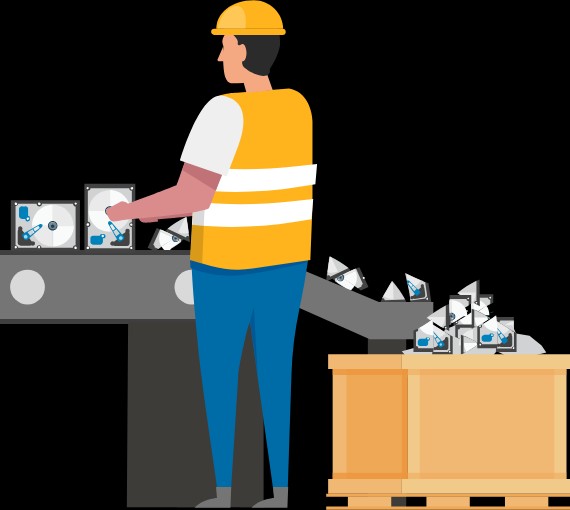Digital technologies have greatly helped many industries become global, more connected to the world, efficient, and productive than any other thing in the history of man, and it seems like this pattern will continue.

However, like with every advantage comes disadvantages. Sometimes, the downside of increased reliance on digital technologies causes a significant increase in the amount of e-waste generated daily. In the United States alone, over 9 million tons of electronic tools are piled into landfills annually. If you expand these parameters globally, the figure will increase to over 50-100 million tons.
Most of this e-waste consists of plastic, silicone, and metal, accounting for 70% of toxic waste generated even though it accounts for only 2% of the total waste generated by humans. E-waste consists of any electronic device, making proper e-waste disposal highly important. Now, the big problem is we only know the manufacturers of these gadgets, you may think disposing of them is very hard; in fact, where will you start?
This article will run through some of the common ways e-waste is disposed of and how you can even dispose of yours, which, at the end of your reading, you will discover is much easier than you imagine.
Research Local Recycling or Disposing Options

The first step in disposing of e-waste is to look for a reputable company that follows waste disposal standards. You can contact the local waste management service to ask for recycling and disposal policies and facilities. You will find many recyclers like Calgary e waste disposal companies that follow the rules and regulations. Remember, once those items are not handled correctly, it will affect the whole environment and ecosystem.
Collection
The second step in e-waste recycling is collecting these items via recycling bins, take-back programs, collection locations, or on-demand collection services. Once this is done, the waste will be sent to professional electronics recyclers.
The waste will then be divided based on types; similar items will be grouped inside multiple bins and boxes. This is essential for items like batteries, as they require extra care to handle and can lead to significant damage if mixed with other dumps.
Thanks to advancements in technology, devices now monitor waste containers. These ultrasonic bin sensors monitor data about the fill level capacity of the bin. The technology also allows you to see the nearest available bin on the map and find the shortest route to quickly dispose of your e-waste successfully.
Visit here https://www.linkedin.com/advice/3/what-most-effective-tools-tracking-monitoring-yfykf?utm_source=share&utm_medium=member_android&utm_campaign=share_via to read more waste on monitoring devices
Storage
Although this alternative is not considered a top priority, it still offers some benefits. For example, glass screens in Cathode Ray Tube (CRT) TVs and monitors contain lead. Back then, these products were recycled into new computer screens. With the emergence of new technology, the demand for CRT reduced, making the majority of these glasses now be stored indefinitely.
Sorting, Dismantling, and Shredding by Hand
These items are then sorted, and each category of similar items is grouped and eliminated for further processing. Some items may be manually disassembled for components, reuse, or material recovery.
How to Dispose E-waste by Yourself
You can give your waste to companies that follow the steps above to get it disposed of. You can also practice some e-waste disposal techniques, which can either extend the lifespan of the products or resell them. Here is a detailed explanation of the process.
- Extend the lifespan
Most companies incentivize purchasing new models of specific gadgets by producing software updates where you can just download a new version of that gadget, such as a smartphone or computer, and you don’t need to change to a new one. This method leads to a reduction in the amount of waste generated by individuals.
- Resell
Consider selling the gadgets through sites like eBay to increase their lifespan. Another person will use the products, or they will be recycled.
Click here to read about how to delete all your personal information if it’s a gadget because it’s essential before reselling the device.
- Repair
Before buying a new electronic device, analyze your current one and see if it can be repaired so the dumps generated will be reduced. Speak with local repair companies around and find a reliable one that will extend the lifespan of your product.
Conclusion
Disposing of e-waste is easier than you think. You can either give it to companies that handle the process. After collecting the waste, they will sort it out based on categories, then dispose of it or dismantle it into pieces and reuse it. You can also practice the process yourself by either selling the items to e-commerce websites that will recycle them or reselling them to someone to use, or you can check and see if there is a way to repair them and use them again.
I am a writer based in London, specialising in finance, trading, investment, and forex. Aside from the articles and content I write for IntelligentHQ, I also write for euroinvestor.com, and I have also written educational trading and investment guides for various websites including tradingquarter.com. Before specialising in finance, I worked as a writer for various digital marketing firms, specialising in online SEO-friendly content. I grew up in Aberdeen, Scotland, and I have an MA in English Literature from the University of Glasgow and I am a lead musician in a band. You can find me on twitter @pmilne100.









